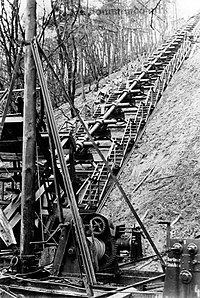V-3 cannon
| Hochdruckpumpe ("high-pressure-pump") |
|
|---|---|

The prototype V-3 cannon at Laatzig, Germany (now Poland) in 1942.
|
|
| Type | Artillery |
| Place of origin | Nazi Germany |
| Service history | |
| In service | 1944 - 1945 |
| Used by | Nazi Germany |
| Wars | World War II |
| Production history | |
| Manufacturer | Krupp |
| Specifications | |
| Length | 130 m (430 ft) |
|
|
|
| Shell | 140 kilograms (310 lb) |
| Caliber | 150 millimetres (5.9 in) |
| Elevation | fixed |
| Traverse | fixed |
| Rate of fire | 300 shells per hour (projected) |
| Muzzle velocity | 1,500 metres per second (4,900 ft/s) |
| Maximum firing range | 165 km |
The V-3 (German: Vergeltungswaffe 3, "Retribution Weapon 3") was a German World War II supergun working on the multi-charge principle whereby secondary propellant charges are fired to add velocity to a projectile.
The weapon was planned to be used to bombard London from two large bunkers in the Pas-de-Calais region of northern France, but they were rendered unusable by Allied bombing raids before completion. Two similar guns were used to bombard Luxembourg from December 1944 to February 1945.
The V-3 was also known as the Hochdruckpumpe ("High Pressure Pump," HDP for short), which was a code name intended to hide the real purpose of the project. It was also known as Fleißiges Lieschen ("Busy Lizzie").
The gun used multiple propellant charges placed along the barrel's length and timed to fire as soon as the projectile passed them in order to provide an additional boost. Solid-fuel rocket boosters were used instead of explosive charges because of their greater suitability and ease of use. These were arranged in symmetrical pairs along the length of the barrel, angled to project their thrust against the base of the projectile as it passed. This layout spawned the German codename Tausendfüßler ("millipede"). The barrel and side chambers were designed as identical sections to simplify production and allow damaged sections to be replaced. The entire gun would use multiple such sections bolted together. The smoothbore gun fired a fin-stabilized shell that depended upon aerodynamic forces rather than gyroscopic forces to prevent tumbling (distinct from conventional rifled weapons which cause the projectile to spin); this resulted in a lower drag coefficient.
The origin of the multi-chamber gun dates back to the 19th century. In 1857, U.S. arms expert Azel Storrs Lyman (1815–1885) was granted a patent on "Improvement in accelerating fire-arms", and he built a prototype in 1860 which proved to be unsuccessful. Lyman then modified the design in collaboration with James Richard Haskell, who had been working for years on the same principle.
...
Wikipedia
